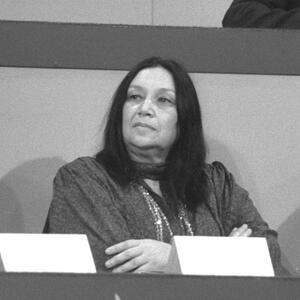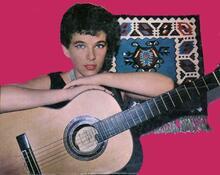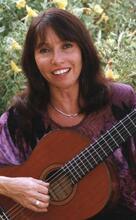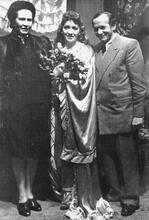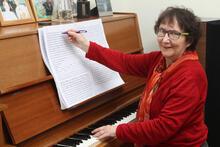Naomi Shemer
Naomi Shemer was a prolific singer and composer who built a unified Israeli cultural consciousness through her beautiful melodies. Her musical skill was evident in her childhood, and her career began in the cultural department of the Nahal military youth organization. After her army service, she became well known through the musical “Five-Five,” essentially an arrangement of her army revue “A Raid in the Village.” From the 1950s to the 1990s, Shemer wrote music that was performed throughout Israel. In 1967, she wrote “Jerusalem of Gold,” subsequently considered the best-loved Israeli song of all time. In 1983, she was awarded the Israel Prize, and she continued to write new music until her death in 2004.
Family, Upbringing, and First Fame
Naomi Shemer was born on July 13, 1930, on A voluntary collective community, mainly agricultural, in which there is no private wealth and which is responsible for all the needs of its members and their families.Kevuzat Kinneret, where both her parents had settled after emigrating from Vilna (Meir Sappir in 1922 and Rivka Shostaliski in 1925). They married in 1925.
Shemer’s musical skill was evident during her childhood, when she began to lead community singing on the kibbutz. After she completed school, she was sent to study at the academy of music in Jerusalem; upon returning to the kibbutz, she taught music to the kibbutz children. During this period she wrote several children’s songs, including “The Short Tour,” “The Post Van,” and “Our Little Brother,” all of which appeared for the first time on an album by Yaffa Yarkoni, “Songs from Kinneret” (1958).
Shemer began her army service in the Nahal, a military youth organization, eventually joining its cultural department. During her military service she wrote several songs for a revue by the Central Command troupe, “A Raid in the Village” (1956), under the pseudonym S. Carmel.
After her discharge she married the actor Gideon Shemer in 1954 and had a daughter, Halleli (b. 1956). The couple lived first on Kevuzat Kinneret and afterwards in Tel Aviv. Shemer became well-known when the musical “Five-Five,” really no more than an arrangement of her army revue “A Raid in the Village,” was staged. The songs “So Much Light and Blue” and “Song of the Grain,” recorded by Rika Zarai, and the very successful “Rely on the Rooster,” performed in 1959 by Ran and Nama (Ran Eliran and Nehama Hendel), became hits.
A Prolific Songwriter
Upon the formation of the Green Onion troupe, most of whose members were former members of the Nahal troupe, Chaim Topol, one of its founders, commissioned several songs from Shemer. These included “Noa” and “Troubadour,” performed by Nehama Hendel when she joined the group in 1957, though “Noa” was taken off the program after several performances.
Shemer wrote “Tenth Anniversary Song,” “Lights Out,” and “Caravan of Horsemen” for the Dudaim, a duo founded in Jerusalem in 1958. Under the pseudonym Eliphaz, she wrote the lyrics of “Caravan of Horsemen” to music by Shimon Yisraeli. In the same year she also wrote “Hamsin” for the Central Command troupe, performed by the actor Ili Gorlitzky, and “On Account of a Nail” for the Northern Command troupe. She wrote “Hoppa Hey” for the Central Command troupe—a song that in 1960 won first place in the international song festival in Pisaro, Italy. As early as that, Uri Kesari wrote in Haaretz: “The goyim were well able to spot the best of Israeli songwriters.”
Shemer wrote “Market Song” for the Tarnegolim in 1961, and in 1963 composed all the songs for the Nahal troupe revue, “Sun in the Desert,” which, like “A Raid in the Village,” was a kind of musical. Among its songs were “Tomorrow,” “Umbrella for Two,” “We’re Starving,” “The Grand Tour,” and “Hide ’n’ Seek.” The same year, Shemer wrote “The Eucalyptus Grove” for the musical revue “How to Break a Heat Wave,” written to mark the fiftieth anniversary of the founding of her birthplace, Kevuzat Kinneret. Later performed by the Nahal’s Entertainment troupe, the song soon became famous.
In 1964 Shemer composed a musical setting for the poem “Kinneret” (“There are the Golan Heights”) by Rahel, originally performed by the Central Command troupe. Later she set to music other poems about the Kinneret by Rahel, including “In My Garden” and “Song (To You and About You),” which were recorded in 1966 by the Shemer Sisters, a group she established in 1966 that disbanded after a year.
Shemer wrote “Builders’ Love,” “Serenade,” “Lovely Doe” (which she translated from French), and “Akhziv” for the first program by the Yarkon Bridge Trio. “Akhziv” was included in the film Dalia and the Sailors (1964), in which the trio appeared.
After separating from her husband in 1967, Shemer visited Paris with her daughter, sending the songs “For You” and “The City in Gray” to the Yarkon Bridge Trio. Shemer also translated French songs into Hebrew, including “Snow White” (performed by the Twins Trio in 1966), “The Birds” (performed by the Nahal Troupe, original French title: “Si Tous Les Oiseaux”), and many songs by Georges Brassens (1921–1981), which she translated for Yossi Banai’s revue, “There Are No Happy Love Affairs.”
"Jerusalem of Gold"
In 1967 Shemer wrote “Jerusalem of Gold” for the annual song festival. Jerusalem Mayor Teddy Kollek had requested that songs about Jerusalem be sung during a break at the Singing and Choral Festival held by the Israeli Broadcasting Authority. In the absence of existing appropriate songs about Jerusalem, musical director Gil Aldama turned to five of the top Israeli composers, including Naomi Shemer, to prepare songs that would be played for first time at this occasion, in which the entire audience would participate in a guided singing activity. As it turned out, only Shemer wrote about Jerusalem, while the other four composers wrote about other topics.
Shemer later recalled:
I wrote “Jerusalem of Gold” that same night. The idea I started with was the Talmudic legend I remembered from my school days about Rabbi Akiva, who lived in poverty, in a hayloft with his beloved wife Rahel, who had been disowned by her father. As he plucked the hay out of her hair, he promised her that one day he would become wealthy and buy her a Jerusalem of Gold [an item of jewelry]. Our teachers, Shoshana and Amminadav, taught us many similar legends. The phrase “Jerusalem of Gold” suddenly shone in my memory as if to say, “Here I am,” and I realized it would be the cornerstone of my song.
Even with that realization, I still had my doubts. One needs to remember how gray and lacking in gold Jerusalem was then, and how one could not speak highly of it or have parades there. Like the saying “Do not wake or rouse” [Song of Songs 2:7], I was awestruck and asked myself: Of gold? Are you sure about the gold? And something answered me: Absolutely, of gold.
It was night by the time I sat down and wrote the song. I began with my fresh, innocent memories of my visits there during summer vacation, and then I continued to “She sits alone” and “captive in her dream,” and to the ancient phraseology which had just presented itself to me as if to say, Take me and do with me as you will.
As for the melody, here I touched upon the hasidic melodies and Yiddish songs of my late father with faint traces of Biblical cantillation. When I got to the refrain, I changed the direction upward, and it was as though I had drawn the curves of the old road near Moza as it approaches Jerusalem, known as the “Seven Sisters”: one ascent, and then another and another, and behold—the city before our eyes.
I wept bitterly as I wrote—“Anything not born in tears is worth little”—and in the last verse I simply reported on all the obstacles that had bound my hands and interfered with my writing until then: “But as I come today to sing to you … I am smaller than the youngest of your children.”
The next day I brought the song to the Voice of Israel. Gil held the lyrics in his right hand and the music in his left and looked at one and then the other, “his cheeks wet with tears” [paraphrased from Lamentations 1:2]. It was Friday, strange weather, it looked like either there might be a heat wave or it might rain. It was around Purim or maybe exactly Purim, and I went to Kinneret to recover from the effort.
I should say that the first version had only two verses, the first and the last, and of course the refrain. …
Over the next few days I played the song for whoever came to visit, as I always do. Once I played it for Rivka Michaeli. She asked: What about the Old City? All right, I said, if you really want it, and I added the middle verse.
The business about the Old City needs an explanation. When I went to write about it, I put all thought of physical, tangible matters out of my mind. I thought about the two thousand years of the Destruction in the abstract, not necessarily about the last nineteen years. Through a kind of telescopic lens I saw before me a city in heaven and the essence which alone I sought to capture.
Naomi Shemer deliberated as to who would sing the song. Her daughter Halleli had heard about an unknown woman soldier with an extraordinary voice, and Shemer was very impressed after hearing her on the radio. She asked to be introduced to the singer and thus met Shuly Nathan. Shemer insisted that Nathan sing “Jerusalem of Gold” with guitar rather than with orchestral accompaniment. The song was indeed performed in that manner and was greeted with tumultuous applause. After the prizes were awarded, the audience stood up, demanding to hear the song again. The second time, the entire audience joined in the refrain. Three weeks later the Six Day War broke out, and Jerusalem was reunited.
The paratroopers who liberated the city sang the song on the Temple Mount and by the Western Wall. After the war, Shemer added another verse, beginning “We have returned to the wells.” When she sang the new version for the paratroopers and they applauded her, she told them: “Actually I should be applauding you, since it is much easier to change a song than to change a city.”
Since the first time “Jerusalem of Gold” was performed at the Song Festival, it has been considered the best-loved Israeli song of all time. (It later won first place in the “Hit of the Hits” parade of 1998, the year of Israel’s fiftieth anniversary, and was chosen as the Jubilee song.) All the Songs of Naomi Shemer was published at the end of 1976.
Later Career
The years after the Six Day War were all marked by Shemer’s songs: “The Two of Us” was written immediately after the Six Day War and sung by the Central Command Troupe. Shuly Nathan continued to perform songs by Shemer that were suited to her unique voice, such as “My Flute.”
In September 1972 a revue of Shemer’s songs was staged, directed by Zadok Zarfati and produced by the Bimot Theater, managed by Yaakov Agmon. The Bimot Company comprised ten singer-actors who sang twenty-four songs and a medley, and the revue appeared to wide acclaim throughout the country.
When the Yom Kippur War broke out in 1973, it was Shemer’s song “Lu Yehi” (“May It Be”) that best expressed the feelings of both the battlefront and the home front. The words were written at the request of the singer Chava Alberstein to the melody of the Beatles’ song “Let It Be.” However, the Hebrew version is not a translation but a version that reflects the mood and the distress of that difficult time.
Shemer’s second husband, Mordechai Horowitz (b. 1926), whom she married in 1969 and with whom she had a son, Ariel, in 1970, felt that words of such high quality deserved a melody “of our own.” At the same time, Israel Television asked Shemer to take part in a program called “Meeting with Artists,” televised live every evening. Shemer wrote the new melody on her way to Herzliya Studios, from which the program was broadcast. That same evening she performed “Lu Yehi” for the first time, accompanying herself on the piano. Chava Alberstein, for whom the song had originally been written, recorded the song, as did the Ha-Gashash ha-Hiver trio. Ha-Gashash later recorded an entire album of songs by Shemer, which included the songs “Daily Joy” and “Messianic Agony.” The Second Book, another collection of Shemer’s songs, was published in 1975. In 1977, Yehoram Gaon recorded the song “Not Ready Yet to Die,” which became a hit. Other songs from the same album which became hits were “Spring Song” (to words by Hayyim Nahman Bialik, 1873–1934), “Landmarks,” and “You Will Not Defeat Me.”
In 1979, when her sister Ruti was widowed, Shemer wrote “Of Sting and Honey” for her as a song of encouragement. Yossi Banai sang it on a television program and included it in his one-man show, “Simon, Little Moïse and I.” Thus, with Banai’s help, the private prayer Shemer had written became the prayer of many, and the line “Do not uproot what has been planted” received political significance when it became the motto of those who opposed the evacuation of Yamit. Many people recorded the song, including Shemer herself, who chose it as the first song on her successful album “The Honey and the Sting” (1981). The songs “Good People” and “There Is a Land” (words by Saul Tchernichowsky, 1875–1943) appeared on the same album.
In 1982 her third collection, Book Three, was published. At the annual Arad Festival, which was launched that year, as well as at subsequent Arad Festivals, Shemer’s songs filled the programs of all the ensembles, every one of which performed at least one or two of her songs.
When Shemer was awarded the Israel Prize in 1983, the judges wrote: “The Israel Prize is awarded to Naomi Shemer for her songs, which everyone sings, because of their poetic and musical merit and the wonderful blend of lyrics and music, and also because they express the emotions of the people.”
In 1987 a revue of songs by her, “Personal Effects,” was produced. The soloist was singer-actor Moshe Becker and all the songs were written especially for him. The Gevatron chorus also recorded an entire album of her songs, “After the Harvest” (1988).
During the 1990s a decline in Shemer’s health affected her writing, but every new song she wrote received a warm welcome. In 1993 she wrote “I Am A Guitar” for Benny Amdursky, which excelled in conveying his character. Amdursky sang it for the first time during a television program dedicated to him shortly before he died of cancer. The song “It’s All Open,” performed by Ofer Levy and Leah Luftin, became a hit, as did “Light” (“Or”), in an arrangement by Matti Caspi, sung by Shoshana Damari accompanied by the Israel Philharmonic Orchestra.
In 1993 the Voice of Israel broadcast a parade of Naomi Shemer’s songs, presenting 220 of them for ranking. At its end, on April 12, 1993, “The Two of Us” won first place.
In 1995, Naomi Shemer: Book Four was published. In the same year, she translated and set to music Walt Whitman’s poem “O Captain! My Captain!” in memory of Yitzhak Rabin.
In 1994 the Hebrew University of Jerusalem awarded Shemer an honorary doctorate and in 2001 she received one from Tel Aviv University. In 2000 she became a member of the Hebrew Language Academy. That year, the revue “A Thousand and One Songs,” comprised entirely of her songs, became a remarkable success.
Naomi Shemer’s songs are sung by everyone—in kindergartens, schools, youth movements, and army units, at events both of rejoicing and of mourning. As the Israel Prize judges wrote: “Naomi Shemer’s melodies are the product of everything she absorbed from her childhood and that flowed from within her due to both her natural and her acquired musical talent.… The unifying factor in all her melodies is their natural, popular musicality… which everyone can comprehend… and this applies to the music and to the lyrics.… For her melodies and her poetry—for all these things—the Israel Prize is awarded to Naomi Shemer.”
Her final piece, Ilan, composed just three weeks before her death, was a tribute to Israeli astronaut Colonel Ilan Ramon (1954–2003), who died in the explosion of the space shuttle Columbia on February 1, 2003.
Naomi Shemer died on June 26, 2004, at Ichilov Hospital in Tel Aviv from consequences of her long bout with cancer. She was buried at her birthplace, Kibbutz Kinneret, overlooking the lake of which she had so often sung. In fulfillment of her request, the mourners at her funeral—broadcast on national television—gave no eulogies; three of her songs were sung instead.
After her death, Israeli Prime Minister Ariel Sharon said, “Using marvelous lyrics and melodies, she succeeded in connecting us to our roots, to our origins, to the beginnings of Zionism. Today, as we bid farewell to Naomi Shemer, we bow our heads with sorrow and are grateful for the wonderful gift Naomi gave us.”
Discography
Naomi Shemer’s songs have been recorded on many hundreds of records, CDs, tapes, videos, etc. She has also published over twelve songbooks. The most important albums are:
Shirim Mi-Kineret (Songs from the Kineret Sea), 1958.
Aech Shovrim Hamsin (How to Break Hamsin), 1975.
Al Hadvash Veal Haoketz (On the Honey and the Sing), 1981.
Naomi Shemer Sharah Naomi Shemer, 2004
Baron, Dan. “Israel’s National Folk Musician, Naomi Shemer, Dies.” JTA, June 27, 2004.
Beck, Mordechai. “Naomi Shemer.” The Guardian, June 29, 2004.
Brauner, Gila Ansell. “Naomi Shemer.” The Jewish Agency for Israel. July 5, 2004 (http://www.jafi.org.il/education/100/people/bios/nshemer.html).
Haetzni, Yishai. “Naomi Shemer.” Azure 19 (Winter 2005).
Saxon, Wolfgang. “Naomi Shemer, 74, Poet and Composer, Dies.” The New York Times, June 29, 2004.
Shemer, Naomi. Road Signs (Hebrew). Or Yehuda: 2003.
Zigman Tamar. Israclassic: Israeli classics and Israeliness in a classical style in Naomi Shemer's songs. Hebrew University, PhD Diss., 2018.

